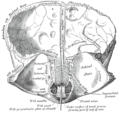Superior sagittal sinus: Difference between revisions
No edit summary |
No edit summary |
||
| Line 15: | Line 15: | ||
Its inner surface presents the openings of the [[superior cerebral veins]], which run, for the most part, obliquely forward, and open |
Its inner surface presents the openings of the [[superior cerebral veins]], which run, for the most part, obliquely forward, and open |
||
| ⚫ | |||
<gallery> |
<gallery> |
||
| ⚫ | |||
Image:Gray193.png|Base of the skull. Upper surface. |
Image:Gray193.png|Base of the skull. Upper surface. |
||
Image:Gray769.png|Diagrammatic representation of a section across the top of the skull, showing the membranes of the brain, etc. |
Image:Gray769.png|Diagrammatic representation of a section across the top of the skull, showing the membranes of the brain, etc. |
||
Revision as of 00:40, 3 December 2012
| {{{Name}}} | |
|---|---|
| Identifiers | |
| MeSH | D054063 |
| TA98 | A12.3.05.109 |
| TA2 | 4856 |
| FMA | 50767 |
| Anatomical terminology | |
The superior sagittal sinus (also known as the superior longitudinal sinus), within the human head, is an unpaired area along the attached margin of falx cerebri. It allows blood to drain from the lateral aspects of anterior cerebral hemispheres to the confluence of sinuses. Cerebrospinal fluid drains through arachnoid granulations into the superior sagittal sinus and is returned to venous circulation. See diagram (at right): labeled above the brain as "SIN. SAGITALLIS SUP." (for Latin: sinus sagittalis superior).
Anatomy
Commencing at the foramen cecum, through which it receives a vein from the nasal cavity, it runs from anterior to posterior, grooving the inner surface of the frontal, the adjacent margins of the two parietal lobes, and the superior division of the cruciate eminence of the occipital lobe. Near the internal occipital protuberance, it drains into the confluence of sinuses and deviates to either side (usually the right). At this point it is continued as the corresponding transverse sinus.
It is triangular in section, narrow in front, and gradually increases in size as it passes backward.
Its inner surface presents the openings of the superior cerebral veins, which run, for the most part, obliquely forward, and open
-
Frontal bone. Inner surface.
-
Base of the skull. Upper surface.
-
Diagrammatic representation of a section across the top of the skull, showing the membranes of the brain, etc.
-
Diagrammatic section of scalp.
-
Human brain dura mater
See also
References
 This article incorporates text in the public domain from page 654 of the 20th edition of Gray's Anatomy (1918)
This article incorporates text in the public domain from page 654 of the 20th edition of Gray's Anatomy (1918)





